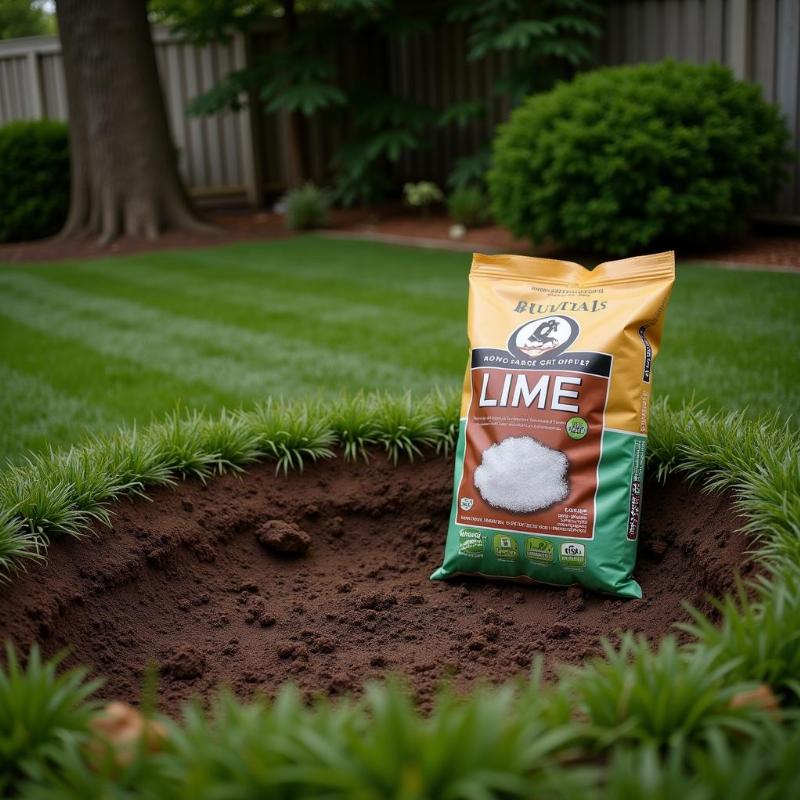Burying a deceased pet is a deeply personal experience, and the idea of using lime often comes up. Many pet owners in the US wonder about the role of lime in this process, searching for answers about its necessity, benefits, and potential risks. This article addresses the common question “lime to bury a dog” and provides clear, factual information to help grieving pet owners make informed decisions.
Understanding the Purpose of Lime in Burial
The primary reason people consider using lime when burying a pet is to accelerate decomposition and control odor. Lime, specifically quicklime (calcium oxide) or hydrated lime (calcium hydroxide), can raise the pH of the soil, creating an alkaline environment that hinders bacterial growth, thus slowing down the decomposition process rather than speeding it up, contrary to popular belief. It can also temporarily neutralize odors. However, this effect is short-lived and can even disrupt the natural decomposition cycle.
 Lime for Dog Burial
Lime for Dog Burial
Is Lime Necessary? The Legal and Environmental Perspective
In most US states, there are no legal requirements to use lime when burying a pet on your property. Local ordinances may vary, so checking with your city or county is recommended. From an environmental perspective, using large amounts of lime can alter the soil pH significantly, potentially harming surrounding vegetation. Natural decomposition is generally the most ecologically sound approach.
Alternatives to Lime for Pet Burial
Several eco-friendly alternatives to lime exist for pet burial. Biodegradable shrouds or pet caskets made from natural materials like wicker or bamboo allow the body to decompose naturally. Choosing a burial site with well-drained soil can also help prevent lingering odors.
Safe Burial Practices for Your Beloved Pet
When burying a pet at home, ensure the grave is at least three feet deep to prevent scavenging animals from disturbing the remains. Choose a location away from water sources to avoid contamination. Wrapping your pet in a biodegradable material can help contain the remains and facilitate natural decomposition.
Dealing with the Grief of Pet Loss
Losing a pet is a significant loss. Remember to allow yourself time to grieve and seek support from friends, family, or pet loss support groups. Creating a memorial, planting a tree, or looking through photos can be helpful ways to remember your beloved companion.
FAQ:
- Does lime help a dog’s body decompose faster? No, lime can actually slow down decomposition.
- Is it illegal to bury a dog in my backyard without lime? In most US states, no, but local ordinances vary.
- What are the environmental concerns of using lime? It can alter soil pH and harm surrounding plant life.
- What are some alternatives to using lime? Biodegradable shrouds or caskets, and choosing a well-drained burial site.
- How deep should I bury my pet? At least three feet deep.
- What can I do to cope with the loss of my pet? Allow yourself time to grieve, seek support, and create a memorial.
- Where can I find more information on pet burial regulations in my area? Contact your local city or county government.
Conclusion
While the use of lime in pet burial is a common misconception, it’s not necessary and can even be detrimental to the environment. Opting for natural decomposition methods and adhering to safe burial practices is a more respectful and environmentally sound way to lay your beloved pet to rest. Remembering the joy and companionship they brought into your life is the most important tribute you can offer.
Beautdogs.us is your premier online resource for all things dog-related in the US. We offer expert advice on dog breeds, care, and lifestyle. Whether you’re a new dog owner or a seasoned expert, Beautdogs.us provides reliable, comprehensive, and engaging information to enhance your dog parenting journey. Contact us today for more personalized assistance. Email: [email protected], Phone: +1 501-555-7529.